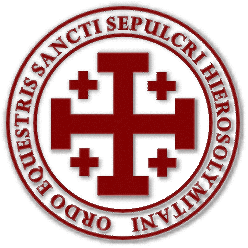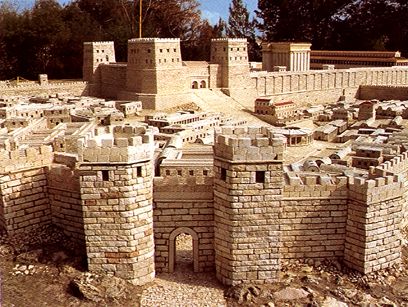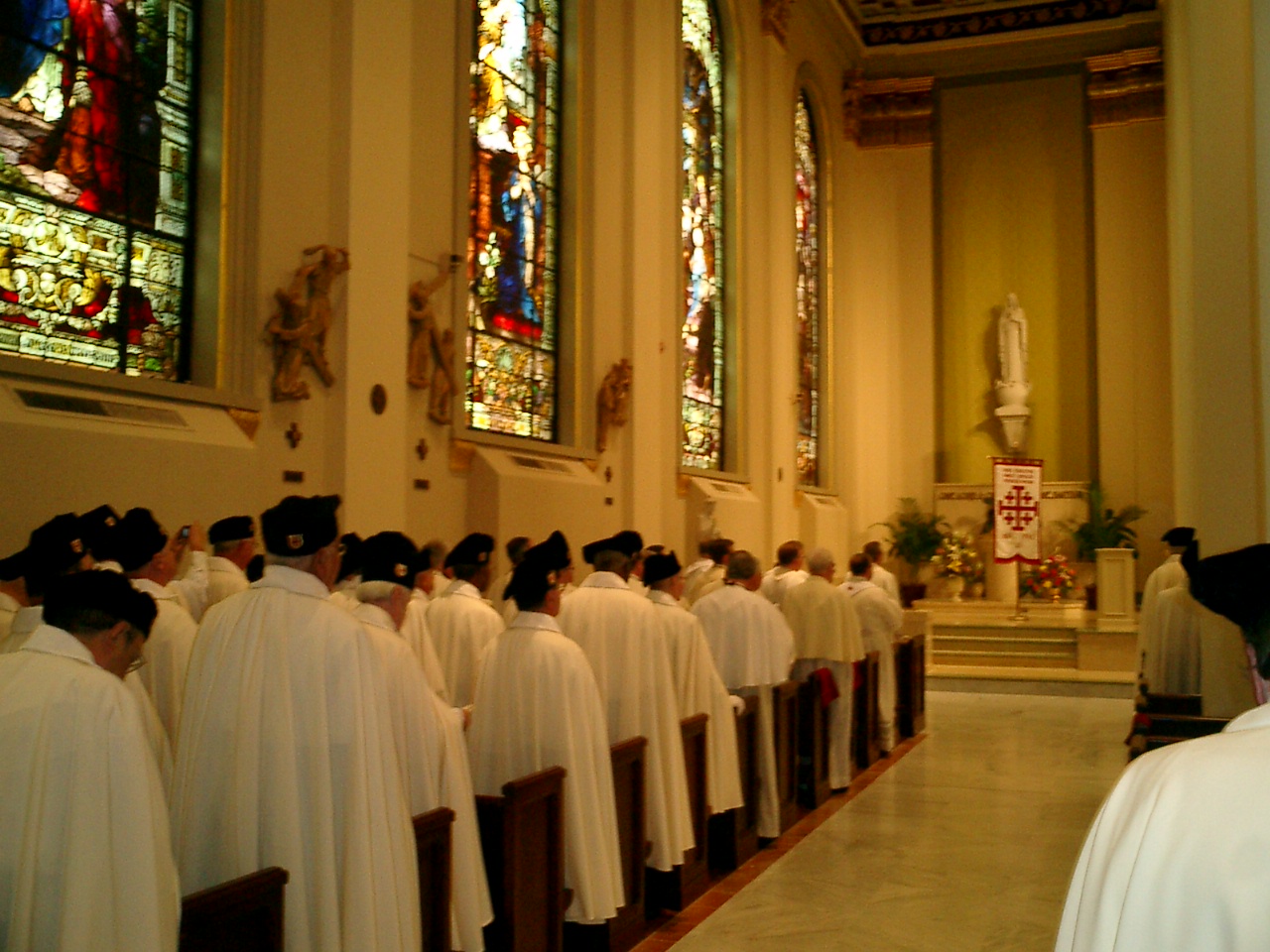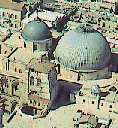"In
the
year
1070
Jerusalem
was
conquered
by
the
Seljuk
Turks
who
immediately
suppressed
Christianity
and
frequently
captured,
murdered,
or
sold
into
slavery
Christian
pilgrims
on
their
journey
to
the
Holy
Sepulchre.
Pope
Urban
II
answered
by
preaching
the
first
Crusade.
Its
success,
in
part,
resulted
from
the
great
battle
cry
first
uttered
by
him
at
Clermont
in
A.D. 1095 ”Deus
Lo
Vult,
God
wills
it."
Though
of
ancient
origin,
the
motto
is
ever
alive
and
vibrant,
for
it
inspires
the
Knights
and Dames
of
the
Holy
Sepulchre
to
crusade
for
equality
of
men,
justice
for
all,
and
peace
in
the
Holy
Land
so
that
Christian,
Jew,
and
Muslim
may
live
side
by
side
in
love
of
God
and
each
other” 'God
wills
it.'
"[1]
The
Equestrian
Order
of
the
Holy
Sepulchre
of
Jerusalem
can
trace
its
origins
to
Godfrey
de
Bouillon
of
the
first
Crusade,
who
gathered
around
him
a
group
of
knights
who
were
entrusted
with
the
protection
of
the
religious
Chapter
of
Canons
who
were
present
at
the
Holy
Sepulchre
of
Christ.
For
twenty
years,
these
knights,
and
those
who
came
to
join
their
number,
protected
the
Christian
presence
at
the
Holy
Sepulchre,
taking
as
their
banner
the
red
Jerusalem
cross
popularized
by
the
crusading
knights.
By
1113,
Pope
Paschal
II
officially
recognized
their
existence
and
purpose.
It
was
not
until
1122
that
Pope
Callistus
II
issued
a
bulla
establishing
them
as
a
lay
religious
community
with
specific
responsibilities
of
guarding
the
Basilica
of
the
Holy
Sepulchre
and
the
city
of
Jerusalem
in
defense
of
Christianity
against
Muslim
attack.
The
Latin
Kingdom
of
Jerusalem
was
established,
and
the
knights
of
the
Holy
Sepulchre
played
an
integral
role
in
advancing
peace
in
the
territory.
The
Muslim
attacks,
however,
did
not
cease,
and
defense
of
the
Basilica
of
the
Holy
Sepulchre ”which
was
built
by
the
earliest
knights
of
the
Order
and
still
stands
today,
covering
both
the
site
of
the
crucifixion
of
Christ
and
His
burial
place” became
impossible.
The
earliest
band
of
knights
fled
to
the
city
of
Acre,
to
the
fortress
of
St.
John,
where
they
were
received
by
other
groups
of
besieged
crusaders.
They
remained
there
from
1245
until
the
great
fortress
fell
to
the
Muslims
in
1291,
ending
the
Latin
Kingdom
of
Jerusalem.
A
diaspora
then
took
place
among
the
Christians
in
Palestine.
Many
of
the
knights
of
the
Holy
Sepulchre
remained
in
the
Mediterranean
basin;
others
fled
as
far
as
France
and
Spain.
The
works
of
the
Order
continued
as
far
away
as
Poland,
where
knights
had
settled
and
later
their
descendants
continued
in
the
spirit
of
the
defense
of
Christianity.
The
activity
of
the
Order,
indeed
its
identity,
in
Palestine
shifted
from
the
knights,
who
returned
to
their
own
countries,
to
the
religious
Order
of
Friars
Minor,
which
had
custody
of
the
monastery
of
Mt.
Zion.
This
group
of
Franciscans
preserved
the
mission
of
the
crusading
knights
of
the
Holy
Sepulchre,
mindful
of
the
original
bulla
of
appointment
that
entrusted
the
basilica,
as
well
as
the
faithful,
to
the
Order's
protection.
In
1330,
Pope
John
XXII
named
the
prior
of
the
Franciscan
house
Custodian
of
the
Order
of
the
Holy
Sepulchre.
The
custodian
served
as
deputy
to
the
pontiff,
who
reserved
unto
himself
the
governing
authority
of
the
Order,
and
yet,
the
custodians,
in
all
effect,
were
responsible
for
all
aspects
of
the
Order's
growth
and
governance,
including
the
calling,
of
new
knights.
In
1489,
Pope
Innocent
VIII
desired
to
suppress
the
Order
and
decreed
that
it
was
to
be
merged
with
the
Order
of
St.
John
(Malta).
For
seven
years,
the
two
lived
all
uneasy,
yet
peaceful,
union.
In
1496,
Innocent's
successor,
Pope
Alexander
VI,
recognized
the
folly
of
this
uneasy
merger
and
restored
the
Holy
Sepulchre
to
independent
status.
Alexander
VI
decreed
that
the
Order
of
the
Holy
Sepulchre
would
no
longer
be
governed
by
the
office
of
custodian
and
further
decreed
that
the
senior
post
of
the
Order
would
henceforth
be
raised
to
the
rank
of
Grand
Master,
reserving
this
title
for
himself
and
his
successors
of
the
See
of
Peter.
The
darkest
period
of
the
Order's
history
began
shortly
after
the
pontificate
of
Alexander
VI,
when
little
is
recorded
of
its
work
or
activity.
Throughout
this
prolonged
era,
with
the
blessing
of
the
Holy
See,
the
Franciscans
of
the
Holy
Land
continued
to
welcome
into
the
Order,
under
the
emblem
of
the
red
Jerusalem
cross,
men
of
great
faith
and
strength
of
character
always
willing
to
defend
the
faith,
even
to
the
shedding
of
their
blood,
and
to
death
when
necessary.
It
Was
not
until
1847,
after
four
hundred
years
of
vacancy,
that
the
Latin
Patriarchate
of
Jerusalem
was
restored
and,
with
it,
the
Order
of
the
Holy
Sepulchre
rose
from
its
dormancy,
from
a
period
of
occasional
growth
to
its
revitalization
under
the
pontificate
of
Pope
Pius
IX.
The
ecclesiastical
superior
of
the
Order
was
then
vested
in
the
Latin
Patriarch
of
Jerusalem,
who
eventually
assumed
the
title
Grand
Prior.
The
office
of
Grand
Master
still
remained
vested
in
the
papacy.
In
keeping
with
the
customs
of
the
royal
houses
of
Europe
prevalent
at
that
time,
Pius
IX
undertook
a
restructuring
of
all
papal
honors,
which
included
the
restructuring
of
the
Order
of
the
Holy
Sepulchre
so
that
it
was
more
closely
linked
to
the
papacy
and
more
formalized
and
uniform
in
structure.
For
twenty
years,
from
1847
to
1867,
Pius
IX
fostered
the
growth
of
the
Order
throughout
Europe.
He
removed
the
requirement
that
a
knight
be
invested
in
Jerusalem.
He
also
encouraged
a
structure
to
form,
with
both
an
ecclesiastical
and
jurisdictional
hierarchy,
so
that
investiture
and
other
works
of
the
Order
could
take
place
throughout
the
world.
Continuing
to
care
for
the
rebirth
of
the
Order,
Pius
IX,
in
1868,
redefined
the
new
classes
or
ranks
of
membership
in
the
Order,
that
of
Grand
Cross,
Commander,
and
Knight.
In
1888,
Leo
XIII
permitted
the
Holy
Sepulchre
to
confer
membership
upon
ladies
of
'society
and
noble
birth,'
the
first
international
order
so
to
do.
Ladies
were
welcome
in
each
of
the
classes
of
membership
without
prejudice.
Actually,
the
first
female
member
was
the
Contessa
Maria
Francesca
di
Tomas,
who
received
the
rank
of
Grand
Cross
in
1871,
predating
the
'official'
welcome
of
female
members
by
seventeen
years.
In
an
attempt
to
assert
its
own
unique
identity
in
the
world,
the
membership
of
the
Order
of
the
Holy
Sepulchre
petitioned
the
Holy
Father
(Pius
XI)
to
nullify
the
terms
identifying
the
Order
as
military
and
sacred,
seeking
a
conferred
sovereign
status.
The
Holy
See
was
neither
prepared
nor
capable
of
doing
so,
as
the
Order
did
not
enjoy
diplomatic
sovereign
status.
Agreeing
that
the
appellation
'sacred
and
military'
was
commonly
used
by
chivalric
societies
not
closely
linked
to
the
Holy
See,
Pius
XI
conferred
in
their
place
the
appellation
'equestrian.'
At
present,
the
full
title
of
the
Order
remains
The
Equestrian
Order
of
the
Holy
Sepulchre
of
Jerusalem.
In
the
first
few
decades
of
the
twentieth
century,
the
senior
leadership
position
of
the
Order
was
held
by
the
reigning
pontiff.
The
offices
of
Grand
Master,
Protector,
and
Custodian
were
used
interchangeably,
albeit
incorrectly,
by
historians
and
members
alike,
when
referring
to
the
Latin
Patriarch's
role
in
the
governance
of
the
Order.
During
this
period
of
time
Plus
IX
intended
the
title
Grand
Master
to
be
reserved
for
the
papacy,
a
political
move
that
linked
the
Order
personally
to
the
pope
without
the
Order
becoming
assimilated
into
the
Holy
See's
own
honors
system.
The
role
of
Grand
Prior,
which
had
supplanted
that
of
Custodian
was
vested
in
the
person
of
the
restored
Latin
Patriarch
of
Jerusalem.
Pope
Pius
X,
in
a
post-risorgimento
posture,
inserted
an
additional
level
of
administration
into
the
Order's
structure
as
he
was
now
in
a
self-imposed
Vatican
exile.
The
office
of
Cardinal-Protector
was
established
to
facilitate
the
Order's
work
in
and
around
Rome
in
lieu
of
the
pontiff,
who
remained
behind
the
Vatican
walls.
In
1949,
Eugene
Pacelli,
Pope
Pius
XII,
restructured
the
Order
once
again
and
relinquished
for
himself
and
his
successors
the
title
and
post
of
(Grand
Master,
vesting
it
in
the
person
of
a
cardinal
of
the
Church
who
assumed
the
title.
The
post
of
Cardinal-Protector,
no
longer
necessary
in
a
post-Lateran
Concordat
world,
was
placed
in
abeyance.
Pius
XII
additionally
bestowed
the
ancient
fifteenth-century
palace
of
Giuliano
Cardinal
della
Rovere,
later
Pope
Julius
II,
as
headquarters
of
the
Equestrian
Order.
Officially
known
as
the
dei
Penitenzieri
it
was
built
by
Julius's
ancestor
Domenico
Cardinal
Della
Rovere
between
1480
and
1490.
It
was
built
to
resemble
the
much
admired
Palazzo
Venezia.
It
took
its
name
from
the
Jesuits,
who,
after
Julius'
pontificate,
occupied
it
as
their
Roman
headquarters.
As
they
were
the
penitentiaries
(or
confessors)
at
St.
Peter's
the
palazzo
took
that
name.
After
the
Lateran
pacts
were
sealed,
Mussolini
attempted
many
gestures
to
warm
relations
with
the
new
Vatican
City
State.
One
such
gesture
was
the
demolition
of
a
width
of
150
yards
of
the
city
of
Rome,
between
the
Square
of
St.
Peter's
and
the
Tiber
River,
known
as
the
Borghi
in
order
to
cut
a
broad
boulevard,
'a'
la
Parisienne,
as
a
ceremonial
entrance
into
the
Vatican.
Named
via
della
Conciliazione*
this
new
broad
boulevard
was
created
by
demolishing
hundreds
of
ancient
buildings
and
palaces.
After
its
completion,
the
new
facade
on
either
side
of
the
new
boulevard
revealed
that
which
was
formerly
well
hidden:
the
palaces
and
shops
of
Renaissance
Rome.
One
such
'hidden'
palace
was
that
of
Julius
II,
the
Palazzo
dei
Penitenzieri.
Today,
it
is
best
known
as
the
Hotel
Columbus,
fronting
the
via
della
Conciliazione
on
the
left
as
one
prepares
to
enter
St.
Peter's
Square.
The
headquarters
of
the
Order
are
housed
in
this
palace,
a
part
of
which
was
set
aside
as
a
hotel
to
earn
income
for
the
Order
and
to
house
pilgrim
knights.
The
offices,
chancellery,
and
residence
of
the
Grand
Master
are
housed
here.
The
church
of
the
Order
is
the
very
small,
ancient
Chapel
of
St.
Humphrey
(S.
Onofrio),
under
the
care
of
the
Franciscans
of
Mt.
Zion,
adjacent
to
the
Bambino
Ges'
Hospital
and
the
Pontifical
North
American
College
on
the
Janiculum
Hill
above
the
Vatican.
The
new
constitution
of
the
Order
was
promulgated
by
Pope
Paul
VI
in
1977,
and
the
Order
now
enjoys
protection
under
canon
law.
This
constitution
clearly
sets
forth
the
reasons
for
its
continued
existence:
The
Order
relives
in
a
modern
manner
the
spirit
and
ideal
of
the
Crusades,
with
the
arms
of
faith,
of
the
apostolate,,
and
of
Christian
charity.
To
this
end
the
Order
(a)
fosters
in
its
members
the
practice
of
the
Christian
life;
(b)
is
zealous
for
the
preservation
and
spread
of
the
faith
in
Palestine;
(c)
champions
the
defense
of
the
rights
of
the
Catholic
Church
in
the
Holy
Land,
the
cradle
of
the
Order.[2]
The
Equestrian
Order
has
grown
tremendously
in
defense
of
the
Faith
during
the
twentieth
century.
With
a
strong
allegiance
to
the
papacy,
serving
it
as
soldiers
of
Christ,
the
members
of
the
Order
are
linked
to
the
Church
in
a
unique
way,
carrying
with
membership
in
the
Order
a
responsibility
of
faithful
witness,
as
well
as
the
dignity
of
being
in
the
service
of
the
papacy.
The
Order
now
comprises
five
classes:
Knights
of
the
Collar,
a
rank
established
by
Pius
XII
in
1949.
There
are
twelve
in
number;
Knights
Grand
Cross:
Commanders
with
Star,
who
are
also
called
Grand
Officers,
an
honor
given
for
special
merit;
Commanders;
simply
Knights.'[3]
Female
honorees
hold
the
same
ranks
or
classes
but
are
known
as
Dame
or
Lady
of
(rank),
depending
on
the
local
custom.
It
is
more
correct,
from
a
protocol
posture,
to
refer
to
female
members
as
Dames
of
(rank);
however,
local
practices
have
established
the
customs
for
each
jurisdiction.
Finally,
unlike
some
chivalric
orders
whose
membership
is
open
to
non-Catholics
and
even
the
papal
orders
of
knighthood
that
admit
non-Catholics
and,
in
some
cases,
non-Christians
alike,
the
Equestrian
Order
of
the
Holy
Sepulchre
is
reserved
solely
for
practicing
Roman
Catholics.
It
is
precisely
that
faith
that
bonds
them
so
closely
to
the
Sovereign
Pontiff.
The
investiture
ceremony
itself
requires
the
pledge
of
defense
of
the
Faith
with
a
Profession
of
Faith,
which,
of
course,
only
the
Catholic
faithful
could
undertake.








